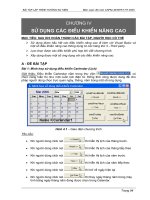Chuong 4 arp rarp
Bạn đang xem bản rút gọn của tài liệu. Xem và tải ngay bản đầy đủ của tài liệu tại đây (659.96 KB, 28 trang )
Chapter 7
ARP and RARP
Objectives
Upon completion you will be able to:
• Understand the need for ARP
• Understand the cases in which ARP is used
• Understand the components and interactions in an ARP package
• Understand the need for RARP
TCP/IP Protocol Suite
1
Figure 7.1
TCP/IP Protocol Suite
ARP and RARP
2
Figure 7.2
TCP/IP Protocol Suite
Position of ARP and RARP in TCP/IP protocol suite
3
7.1 ARP
ARP associates an IP address with its physical address. On a typical
physical network, such as a LAN, each device on a link is identified by a
physical or station address that is usually imprinted on the NIC.
The topics discussed in this section include:
Packet Format
Encapsulation
Operation
ARP over ATM
Proxy ARP
TCP/IP Protocol Suite
4
Figure 7.3
TCP/IP Protocol Suite
ARP operation
5
Figure 7.4
TCP/IP Protocol Suite
ARP packet
6
Figure 7.5
TCP/IP Protocol Suite
Encapsulation of ARP packet
7
Figure 7.6
TCP/IP Protocol Suite
Four cases using ARP
8
Note:
An ARP request is broadcast;
an ARP reply is unicast.
TCP/IP Protocol Suite
9
Example 1
A host with IP address 130.23.43.20 and physical
address B2:34:55:10:22:10 has a packet to send to
another host with IP address 130.23.43.25 and
physical address A4:6E:F4:59:83:AB (which is
unknown to the first host). The two hosts are on the
same Ethernet network. Show the ARP request and
reply packets encapsulated in Ethernet frames.
See Next Slide
TCP/IP Protocol Suite
10
Example 1
(Continued)
Solution
Figure 7.7 shows the ARP request and reply packets.
Note that the ARP data field in this case is 28 bytes,
and that the individual addresses do not fit in the 4byte boundary. That is why we do not show the
regular 4-byte boundaries for these addresses. Also
note that the IP addresses are shown in hexadecimal.
For information on binary or hexadecimal notation
see Appendix B.
See Next Slide
TCP/IP Protocol Suite
11
Figure 7.7
TCP/IP Protocol Suite
Example 1
12
Figure 7.8
TCP/IP Protocol Suite
Proxy ARP
13
7.2 ARP PACKAGE
In this section, we give an example of a simplified ARP software package
to show the components and the relationships between the components.
This ARP package involves five modules: a cache table, queues, an
output module, an input module, and a cache-control module.
The topics discussed in this section include:
Cache Table
Queues
Output Module
Input Module
Cache-Control Module
TCP/IP Protocol Suite
14
Figure 7.9
TCP/IP Protocol Suite
ARP components
15
Table 7.1 Original cache table used for examples
TCP/IP Protocol Suite
16
Example 2
The ARP output module receives an IP datagram
(from the IP layer) with the destination address
114.5.7.89. It checks the cache table and finds that an
entry exists for this destination with the RESOLVED
state (R in the table). It extracts the hardware address,
which is 457342ACAE32, and sends the packet and
the address to the data link layer for transmission.
The cache table remains the same.
TCP/IP Protocol Suite
17
Example 3
Twenty seconds later, the ARP output module receives
an IP datagram (from the IP layer) with the
destination address 116.1.7.22. It checks the cache
table and does not find this destination in the table.
The module adds an entry to the table with the state
PENDING and the Attempt value 1. It creates a new
queue for this destination and enqueues the packet. It
then sends an ARP request to the data link layer for
this destination. The new cache table is shown in
Table 7.2.
See Next Slide
TCP/IP Protocol Suite
18
Table 7.2 Updated cache table for Example 3
TCP/IP Protocol Suite
19
Example 4
Fifteen seconds later, the ARP input module receives
an ARP packet with target protocol (IP) address
188.11.8.71. The module checks the table and finds
this address. It changes the state of the entry to
RESOLVED and sets the time-out value to 900. The
module then adds the target hardware address
(E34573242ACA) to the entry. Now it accesses queue
18 and sends all the packets in this queue, one by one,
to the data link layer. The new cache table is shown in
Table 7.3.
See Next Slide
TCP/IP Protocol Suite
20









